The word itself comes from the Old French entremes, which stems from entre– meaning “between” and mes or “dish.” Entremets started out as small dishes served between courses but became more elaborate as time went on, eventually becoming associated more with entertainment than with actual food.
One of the first mentions of entremets in print is in a cookbook from the late 1300s by Guilliame Tirel, a chef in the French royal court, with detailed instructions for skinning, cooking and then restuffing swans and peacocks, complete with their original feathers, for the delight and awe of banquet guests. By the 1400s, these intricate dishes that marked the end of one course and the onset of another took on even more elaborate designs, such as edible materials shaped into castles inhabited by knights, woodsmen and animals fashioned out of various meats, and featuring fountains of wine from which guests could fill their glasses.
Later that century, the entertainment portion of entremets became more prominent than the food, often featuring theatrical displays, singers, dancers, and live wild animals . One example is immortalized in the nursery rhyme, “Sing a Song of Sixpence,” where live birds were slipped into a baked pie shell through a hole cut in the bottom so that when the pie was cut into the birds were released. This was reenacted by British chef Heston Blumenthal in 2010, except he substituted pigeons for blackbirds (which are a protected species in the UK). In England, these exotic, if inedible, dishes were called subtleties, from an older meaning of the word denoting “clever” or “surprising.”
Thankfully, the entertainment aspect of entremets faded with time, and what we are left with today is a dessert made up of multiple layers of different flavors, textures and colors meant to show off the pastry chef’s prowess.

For this challenge, Paul and Mary asked the bakers in the Great White Tent to make 24 entremets, 12 each of two kinds.
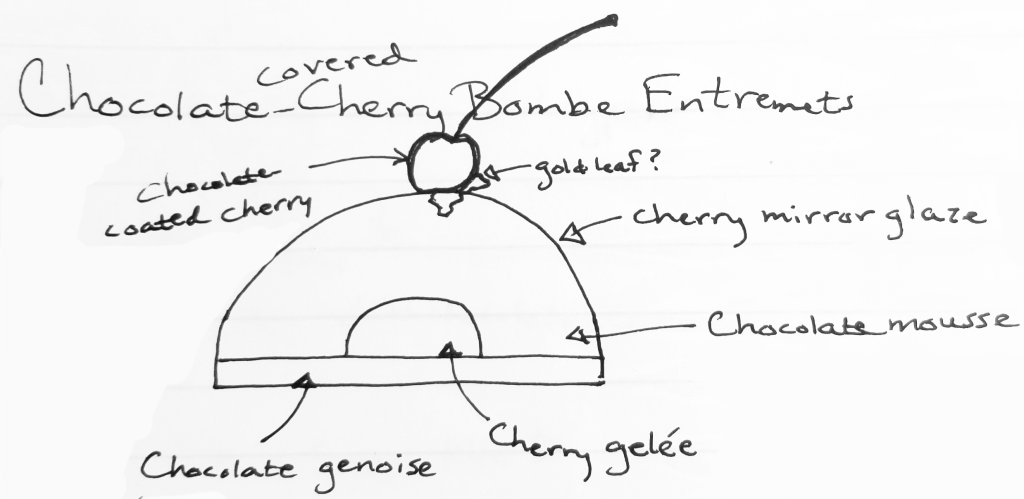
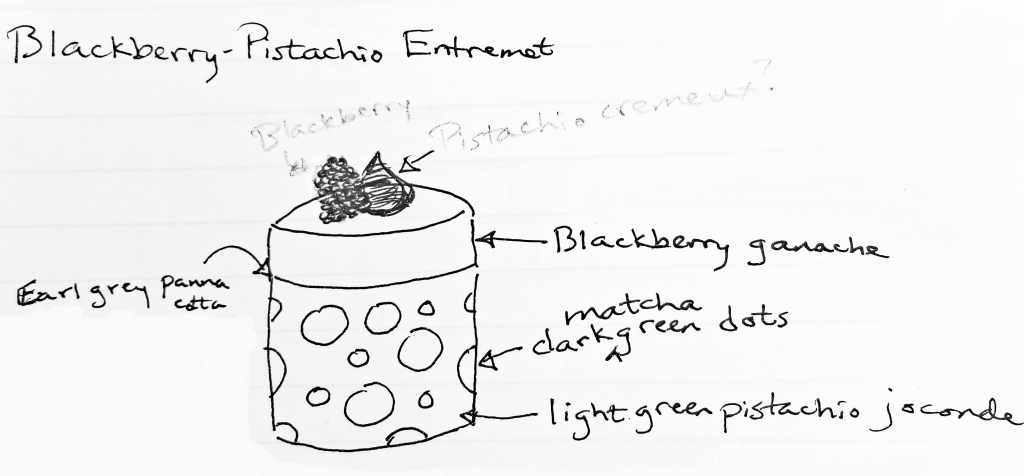
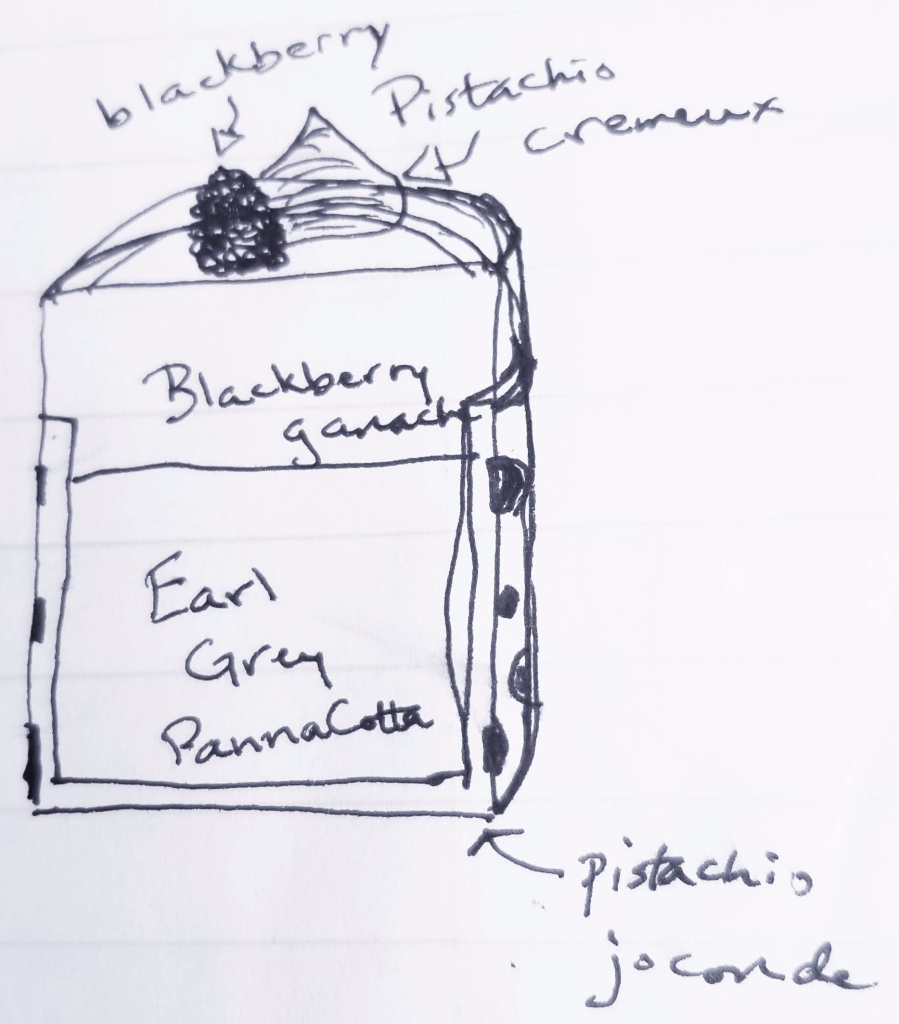
My first entremets are called Chocolate Cherry Bombes, with a cherry gelée hemisphere sitting atop a chocolate genoise base, surrounded by chocolate mousse, covered with a red mirror glaze, topped with a chocolate-covered cherry and garnished with a little edible gold leaf. My second entremets, which I’m calling “Twofer Tea” (because you’re getting two tea flavors in one, and then there’s the old song “Tea for Two and Two for Tea.” … Get it?) feature a pistachio joconde sponge with matcha polka dots surrounding a filling of earl grey panna cotta and blackberry ganache topped with pistachio cremeux and garnished with a blackberry and a mint leaf.
The key to making entremets without driving yourself crazy is to spread it out over several days. Most of the elements can be made in advance and kept in the fridge or freezer for a few days until you’re ready to assemble the whole thing. Of course, the Great British Bake Off contestants didn’t have that luxury; they only had five hours to complete all 24 entremets. But since we’re not constrained by artificial time limits such as those, I’ve divided my recipes into sections that can be completed over three days. You’re certainly welcome to shorten the time frame, or even stretch it out longer if you need to take a day off in between, but I’ve tried to break it down into reasonable segments.
Here’s how I’ve divided each recipe:
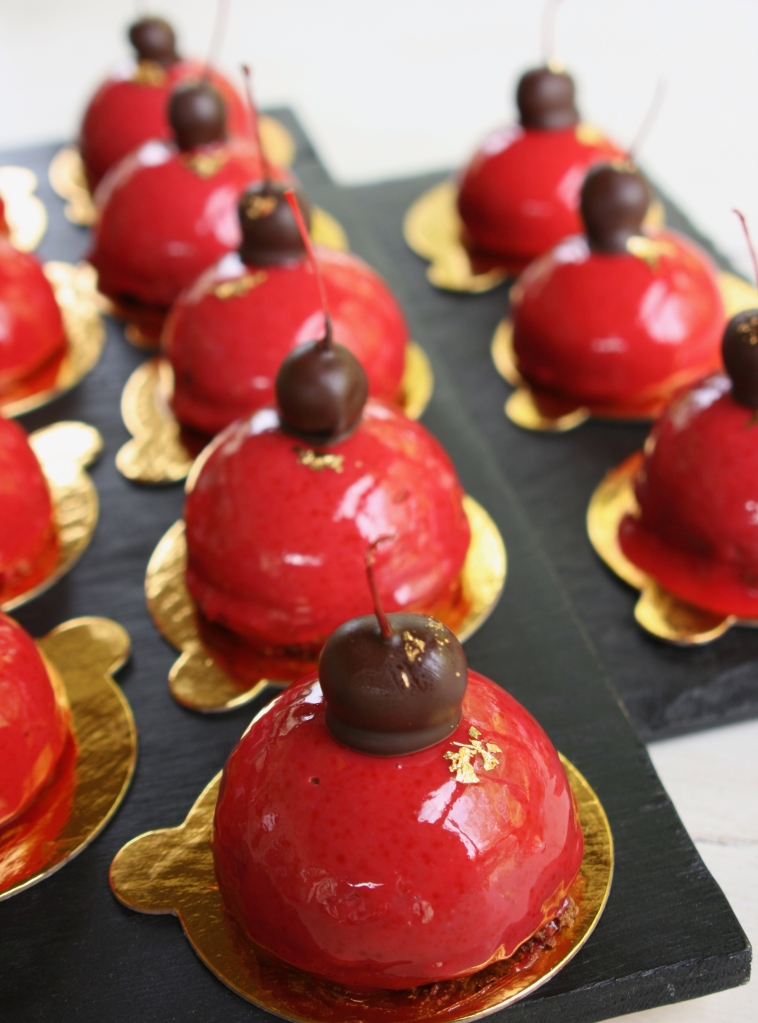
Chocolate Cherry Bombes Day 1—Make the cherry gelée. Day 2—Make the genoise and chocolate mousse. Day 3—Make chocolate-covered cherries and mirror glaze and assemble.
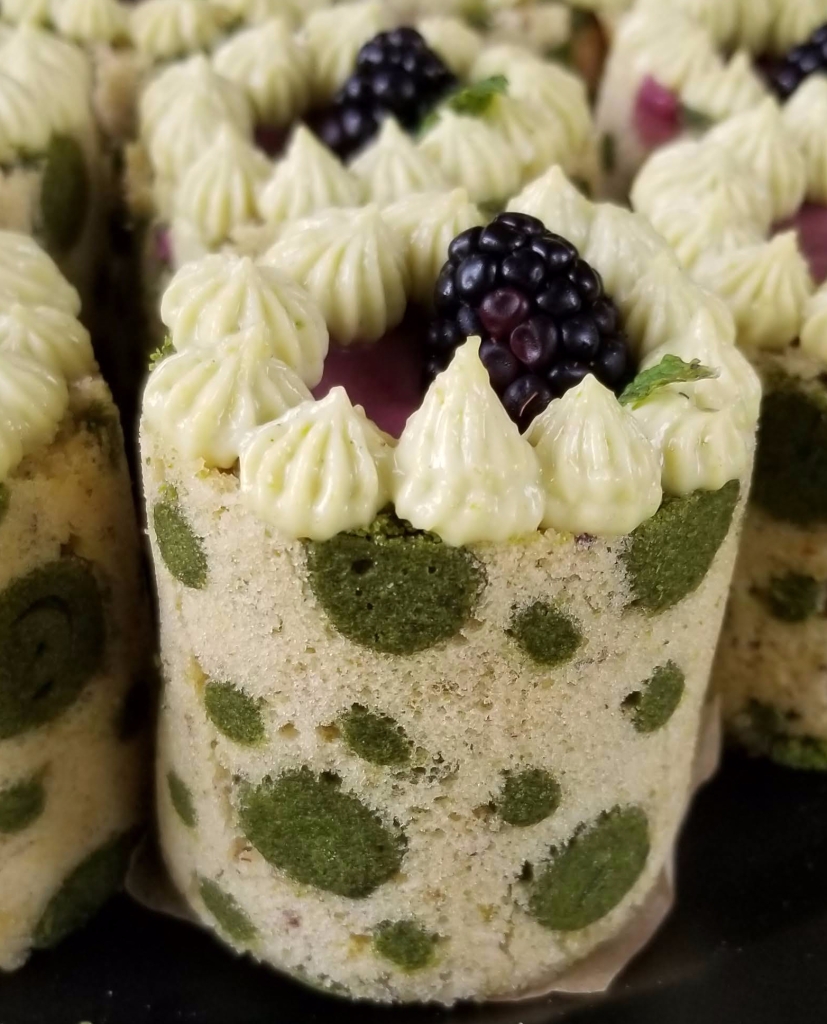
Twofer Tea Blackberry-Pistachio Entremets Day 1—Make the joconde and imprimé. Day 2—Make the panna cotta and cremeux. Day 3—Make the ganache and assemble.
Rather than go into a lot of detail about my process here, I’ll get straight to the recipes. And to give credit where credit is due, here are the recipes I used in both entremets: For the Chocolate Cherry Bombes, I found the gelée recipe on the Institute of Culinary Education website; the chocolate genoise recipe came from AskChefDennis.com; the chocolate mousse is from BakedByAnIntrovert.com; the mirror glaze is from LoveAndOliveOil.com; and the chocolate-covered cherries is a recipe from Food52.com. For the Twofer Tea entremets, I adapted the joconde recipe from CannelleVanille.com (which I also used in my Watergate Opera Cake); I used the joconde décor (imprimé) paste recipe from a blog called From the Kitchen of Olivia; the blackberry ganache and pistachio cremeux recipes came from InLoveWithCake.com; and the panna cotta recipe comes from Taste of Home.
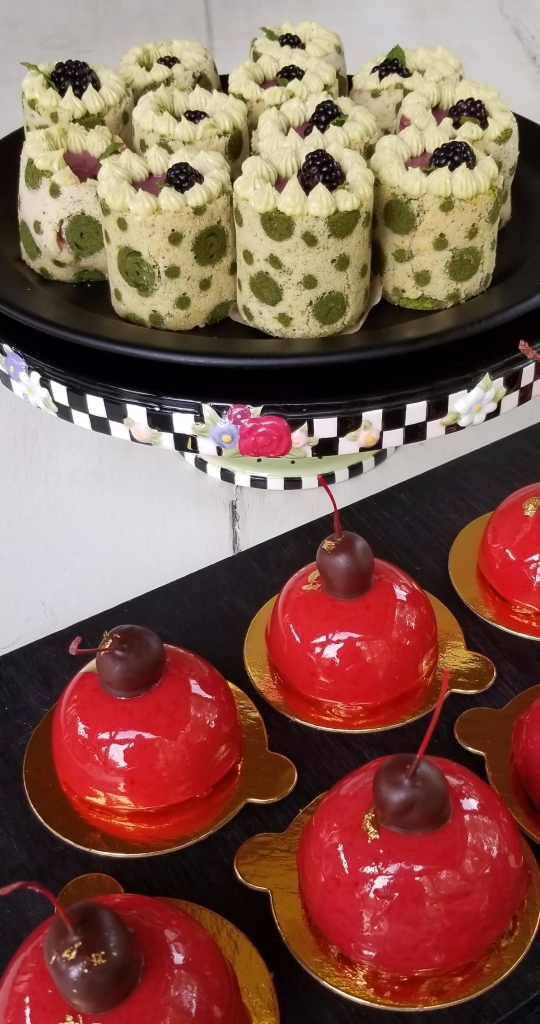
Both went over well at my birthday dinner (Yes, they filled the role of my birthday cake this year.), and I had plenty left over to share with friends. The Chocolate Cherry Bombe is a classic flavor combination, and the chocolate mousse has a rich, melt-in-your-mouth smoothness that can’t be beat. The Twofer Tea entremets have a more complex flavor profile, but the earthiness of the matcha is a good counterbalance to the sweet ganache, and the panna cotta leaves a clean, refreshing finish on the palate.

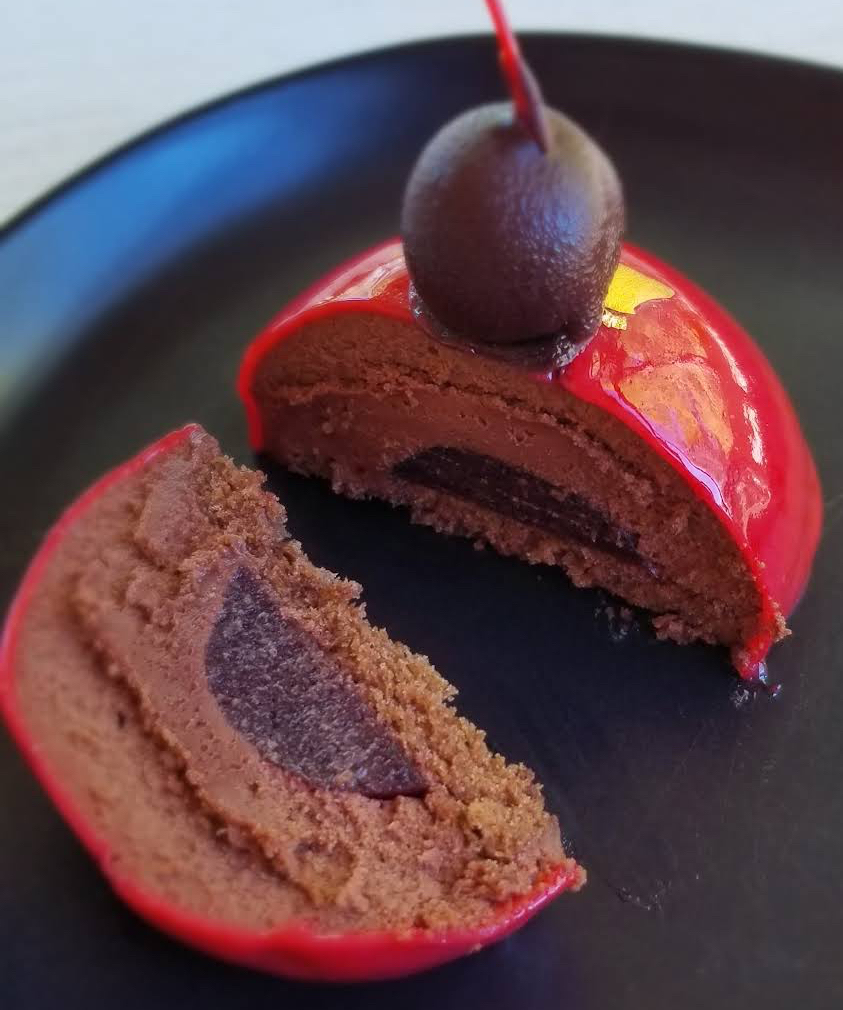
Chocolate Cherry Bombe Entremets
For the gelée:
- ¼ c. sugar
- 3 t. kirschwasser (or lemon juice)
- 1½ t. powdered gelatin
- 2 T. water
Directions
- Combine cherries, sugar and kirsch (or lemon juice) in a small saucepan. Bring to a simmer over medium heat and simmer until cherries are softened and bursting. Transfer to a small measuring pitcher and use a hand blender to puree until smooth.
- Sprinkle gelatin over cool water and let stand for 1 minute, then add to puree and whisk until completely dissolved. Transfer back to saucepan and heat until it just barely begins to bubble. Pour mixture into 1½-inch-diameter silicone dome molds and refrigerate overnight until set. Before unmolding, stick them in the freezer for about half an hour.
For genoise:
Directions
- Preheat oven to 400°F and set a rack in the middle of the oven. Lightly spray a 12×17-inch rimmed baking sheet with vegetable oil spray and line with parchment paper. (My pan is about 11×16, which just made for a slightly thicker sponge.) Lightly spray the parchment, as well.
- Whisk eggs, egg yolks, vanilla, salt and sugar together in a large bowl over a pan of simmering water. Whisk gently until mixture is lukewarm, about 100°F. Transfer mixture to the bowl of a stand mixer fitted with a whisk attachment, and whisk on medium-high speed until the egg mixture is cooled and tripled in volume. It will be thick and should form a slowly dissolving ribbon falling back into the bowl when the whisk is lifted.
- Over a medium bowl or wax paper, sift together the flour and cocoa. Add one-third of the flour mixture to the beaten egg mixture, using a rubber spatula to fold it in. Make sure to scrape all the way to the bottom of the bowl to prevent lumps. Repeat with another third of the flour mixture and then the remainder. Pour the batter into the prepared pan, and smooth the top with an offset spatula.
- Bake for 10-12 minutes until the cake springs back when touched lightly. Don’t overbake or it will dry out. Cool the cake on a rack, then invert the pan onto a larger piece of parchment to remove the cake from the baking sheet. Carefully peel off the parchment and set the cake aside. When completely cooled, use a round biscuit or cookie cutter to cut circles of cake exactly the same size as (or slightly smaller than) the base of the molds to be used for the bombes. Place in an airtight container, stacked with wax paper between layers.
For mousse:
Directions
For chocolate-dipped cherries:
Directions
- Rinse the cherries and spread them on a dishtowel or layers of paper toweling. Pat dry and cover them with another towel and refrigerate. Cherries must be cold and completely dry before dipping. If necessary, wipe each cherry with a paper towel before dipping it — wet cherries will make the chocolate thick and dull.
- Line a tray with wax paper. Put the chocolate in a small, dry, stainless steel bowl. Bring an inch of water to a simmer in a wide skillet. Set the bowl directly in the skillet and keep the water at or below a simmer. Stir chocolate occasionally. Remove the bowl from the skillet when the chocolate is almost entirely melted. Wipe the underside of the bowl dry, and stir until chocolate is completely melted. Chocolate should be warm but not hot to the touch.
- Pick up a cherry by the stem and dip it into the chocolate, swirling until it is completely covered. Lift the cherry above the chocolate and shake gently to remove excess chocolate. Set the cherry on the lined tray and repeat with remaining cherries. Refrigerate as soon as all the cherries are coated. Keep chilled until you are ready to decorate the entremets.
For mirror glaze and assembly:
Directions
- Cut gelatin into 1-inch strips and submerge them in cool water for at least 5 minutes to soften. Roughly chop the white chocolate, place it in a heat-proof bowl and set aside.
- Combine sugar, corn syrup and ½ cup water in a saucepan and bring to a boil over medium heat until sugar is completely dissolved and mixture is clear. Remove from heat.
- Squeeze as much water out of the gelatin as possible, then add gelatin to the pan and whisk until dissolved. Whisk in the sweetened condensed milk. Pour the hot mixture over the white chocolate and let sit for 30 seconds, then stir until chocolate is completely melted and mixture is smooth. (You can also use an immersion blender to expedite the process; just try not to mix air bubbles into the glaze.)
- Let glaze cool, stirring occasionally, until it reaches approximately 95°F. (The glaze needs to be the correct temperature or it will not form a thick enough layer on the cake.) When the glaze reaches 95-96°F, add gel food coloring, a little at a time, until desired color is reached.
- Place a muffin tin upside down on a cooling rack set inside a rimmed baking sheet. Remove the mousse-filled molds from the freezer and turn them out of the molds. (You may want to work with only six at a time.) Place them on top of the muffin tin, rounded side up.
- Pour glaze generously over mousse, making sure there are no bare spots. Allow excess glaze to drip off for 5-10 minutes, then gently scrape the edges to remove any remaining drips. Use a small offset spatula to carefully transfer the entremets to a serving platter. (You may also want to place them on individual-sized cardboard cake circles, doilies or small pieces of parchment paper to make it easier to serve them.)
- If you’re working in batches and the glaze gets too cool and stiff, you can rewarm it in a double boiler or in very short intervals in the microwave. Leftover glaze can be scraped from the pan (unless it’s full of cake crumbs, like mine was) and refrigerated in an airtight container for later use.
- Refrigerate the glazed entremets until ready to serve. Before serving, top each with a chocolate-covered cherry and a bit of gold leaf*, if desired. These entremets will keep for a few days in the fridge. You could freeze them, but the mirror glaze will lose its luster.
*If using edible gold leaf for the first time, I recommend watching a tutorial on how to work with it, like this video: https://www.youtube.com/watch?v=KfejJMU3B7Q. (Skip to 17:00 to see how she applies gold leaf to the truffles.) Don’t touch it with your bare hands or it will stick! Use a paintbrush or tweezers.
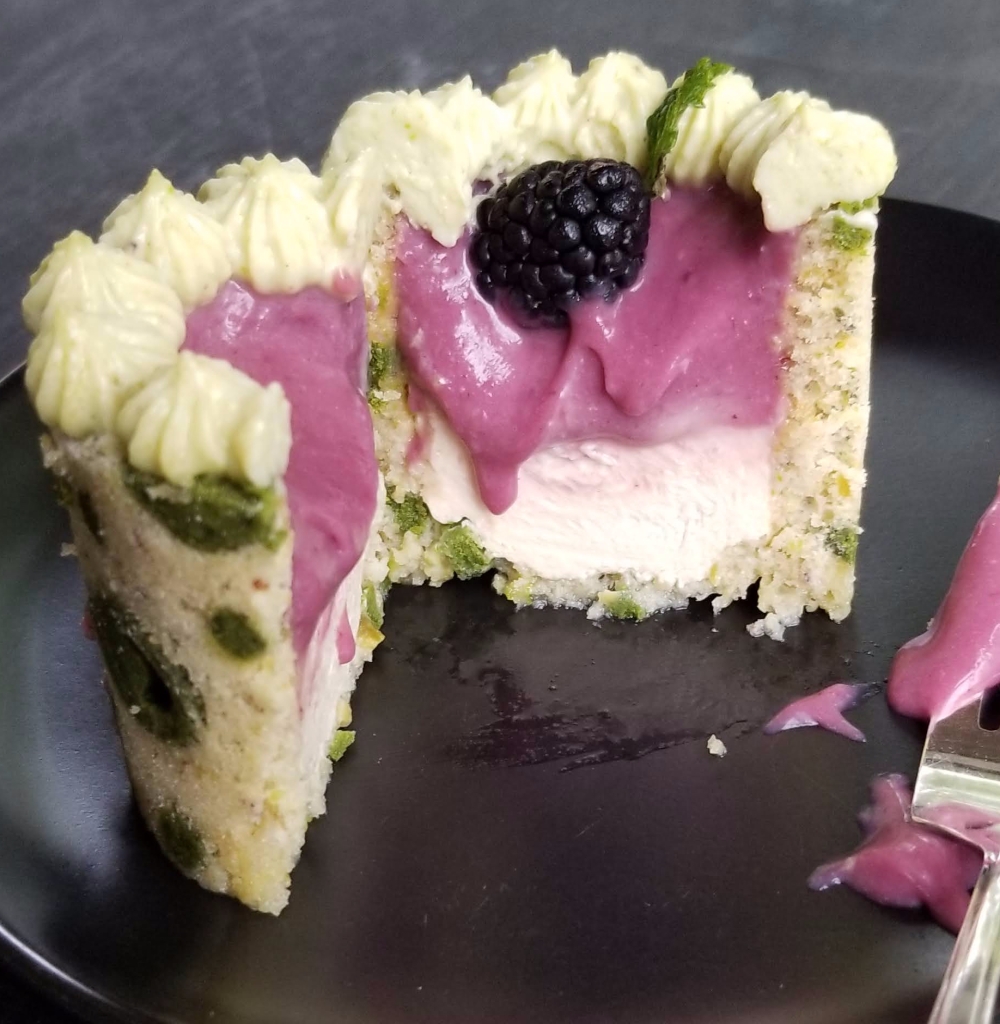
‘Twofer Tea’ Blackberry-Pistachio Entremets
Joconde recipe adapted from CannelleVanille.com
Credit for pistachio cremeux and blackberry ganache: InLoveWithCake.com
Credit for panna cotta: TasteOfHome.com
For imprimé paste:
- ¾ c. + 3 T. powdered sugar
- 3½ oz. egg white (about 3½ large egg whites)
- ¾ c. cake flour
- 4 T. matcha green tea
Directions
- Cream butter and sugar together until light and fluffy. Gradually add egg whites and beat continuously until emulsified. Sift together flour and matcha tea powder and fold into batter. Transfer to a piping bag fitted with a small round tip.
- Place a silicone baking mat on each of two flat baking sheets. Pipe polka dots of various sizes in a random pattern onto the silicone. Transfer baking sheets to freezer while preparing joconde batter. (Freeze for at least 15 minutes before topping with joconde batter.)
For pistachio joconde:
Directions
- Finely chop the pistachios in a food processor. Add the powdered sugar and almond flour and process until it forms a fine meal. Place this mixture in the bowl of an electric mixer fitted with a whisk attachment. Add the flour and the whole eggs and whisk until it forms a thick ribbon that slowly dissolves as it falls back into the bowl when the whisk is lifted — about 5 minutes.
- Place the egg whites in another clean bowl of the electric mixer fitted with a clean whisk attachment (or, if you only have one mixer bowl and whisk attachment, transfer the egg mixture into another bowl and wash and dry the mixer bowl and whisk). Whisk until a light meringue starts to form, then slowly sprinkle in the sugar and continue whisking until semi-stiff peaks form.
- Stir a third of the meringue into the first mixture, then add the rest of the meringue and gently fold it in. Add the melted butter and fold in until it is all incorporated. (NOTE: Don’t miss this step! I had spread the batter onto one baking sheet before I discovered my butter still sitting on the counter. I folded half of it into the remaining batter, and I definitely could tell a difference. The first sponge turned out drier and more crumbly, so it was harder to form into cylinders.)
- Preheat oven to 450°F. Remove baking sheets with the imprimé paste from the freezer and spread half the joconde batter evenly over each one, as thin as possible. Bake for about 5 minutes, or until the sponge is just starting to brown slightly. Remove from oven and allow to cool for about 5 minutes. Dust top of each sponge lightly with flour and invert it onto a baking sheet lined with parchment paper. Leave to cool completely.
- Cut 12 food-grade acetate strips, 3 inches wide by 8 inches long. Roll into tubes, overlapping the ends of the strips by 1 inch, and seal with tape on the outside. When joconde sponge is completely cool, cut 12 strips, 2 inches wide by 7 inches long. Roll up and insert these sponge strips into the acetate tubes, trimming to fit if necessary. Cut 12 circles out of the remaining joconde to fit inside the cake cylinders. Push them down to the bottom of each cylinder, trimming with scissors if needed. Place these tubes in a muffin tin and freeze until ready to fill.
For panna cotta:
Directions
- In a small saucepan, sprinkle gelatin over half and half; let stand 1 minute. Stir in sugar and salt. Heat and stir over low heat until gelatin and sugar are completely dissolved. Remove from heat. Add tea bags and steep, covered, for 10-15 minutes. Strain through a fine-mesh sieve (or discard tea bags). Pour mixture into a bowl and cover with plastic wrap pressed onto the surface of the mixture. Refrigerate until slightly thickened but not set. Transfer to a piping bag fitted with a plain round tip. Fill the joconde cylinders half full with panna cotta. Freeze until ganache is ready.
For cremeux:
Directions
- Soak gelatin sheets in cold water for 10 minutes. Meanwhile, heat the milk in a saucepan to a simmer. In a heatproof mixer bowl, whisk together egg yolks, sugar and cornstarch. Slowly pour hot milk over the egg yolks while whisking, then return mixture to the same saucepan. Heat to 180-185°F, stirring continuously with a whisk.
- Transfer mixture to a clean bowl. Squeeze as much water out of the gelatin as possible and add gelatin to the pastry cream. Mix with a whisk until melted, then add the pistachio paste and mix again until the mixture is homogeneous and smooth. Cover with plastic wrap pressed onto the surface of the cream and set aside to cool slightly, to 95-104°F.
- Pour the cream into a glass measuring cup and add the butter little by little, mixing with a hand blender on low so as not to add air, until it has a velvety smooth texture. (It is important to add the butter while the cream is lukewarm so it doesn’t separate in the fridge.) Cover with plastic wrap pressed onto the surface of the cremeux and refrigerate overnight.
For ganache and assembly:
Directions
- Reserve 12 small but well-formed blackberries for garnish. Place the remaining blackberries in a food processor or blender. Process until pureed. Strain through a fine-mesh sieve and discard solids. Measure out ¾ cup of puree and heat in microwave without boiling (30-60 seconds). (Save any remaining puree to serve over ice cream, pancakes or yogurt.)
- Follow package directions to melt white chocolate in microwave to 113°F. Pour one-third of the hot puree over the melted white chocolate, stirring with a spatula in a circular pattern until well combined. Repeat with one-half of remaining white chocolate, followed by the rest of the white chocolate, stirring until ganache is smooth and glossy. Allow to cool slightly. When it starts to set, remove joconde cylinders from freezer and pour ganache over the panna cotta until each one is full. Place in freezer to set before decorating.
- When ready to decorate entremets, transfer pistachio cremeux to a disposable piping bag with a small star nozzle. Remove cakes from freezer and carefully remove acetate cylinders. Place each cake onto a small piece of parchment or an individual-sized cardboard cake circle. Pipe a circle of cremeux stars around the top edge of each cake. Place a blackberry and a small mint leaf on the surface of the ganache. Freeze until ready to serve.
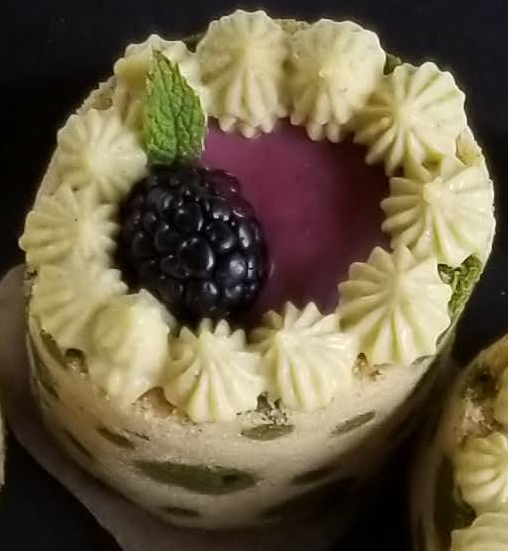

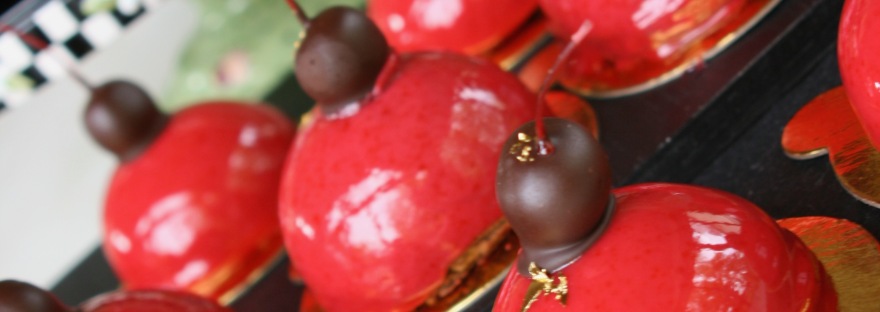

2 thoughts on “Entremets”